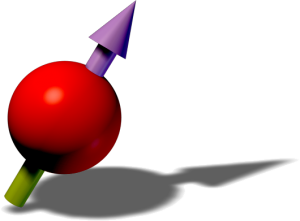by Maximilian Sohmen
Abstract:
In experimental physics, quantum gases of ultracold atoms have proved, on the one hand, an extremely productive subject of study for its own sake, and on the other hand, a helpful tool to simulate and understand other, less accessible quantum many-body systems. The vast majority of quantum gas experiments so far has utilised atoms that interact through an isotropic, short-ranged, contact-type interaction. More recently, experiments using atoms of strongly magnetic elements such as chromium, erbium, and dysprosium have been realised, whose physics can be heavily influenced by the anisotropic and longranged dipole-dipole interaction. One part of this thesis reports on studies of three-dimensional bulk quantum gases of erbium and dysprosium sufficiently confined in the direction of dipole polarisation. In such systems, a carefully balanced interplay between repulsive contact interaction, attractive dipole-dipole interaction, and fluctuations can lead to the spontaneous formation of density-modulated states. Within a narrow parameter regime, these states can combine features of a crystal (spatial periodicity) and of a superfluid (phase coherence), manifesting a so-called supersolid – a counter-intuitive phase of matter whose existence has been speculated about for more than 60 years. A first set of experiments demonstrates the creation of supersolid states from Bose–Einstein condensates of 166Er as well as 164Dy through a ramp of the contact interaction, and allows comparison to a phase diagram calculated from an extended Gross–Pitaevskii equation. Dysprosium supersolids are not only found to be particularly long-lived, but also to be producible through direct evaporation from a thermal gas. This process is studied more closely in a second set of experiments. It is observed that during evaporation into the supersolid state the translational symmetry is broken before the phase symmetry, and that thermal excitations enhance the measured degree of density modulation. A third set of experiments is aimed at dysprosium supersolids brought out of equilibrium. It is found that after a contact interaction quench that breaks the supersolid into an incoherent array of isolated quantum droplets, global phase coherence can be restored by increasing the Josephson coupling between the droplets. Another part of this thesis reports on the development and construction of a quantum gas microscope for dipolar erbium and dysprosium atoms. Single-atom-resolved imaging of ultracold lattice gases has in the past enabled impactful studies of contact-interacting many-body systems. The extension of this technique to dipolar systems will allow to probe extended Bose–Hubbard and extended Fermi–Hubbard models, opening new research perspectives and allowing for advanced quantum simulation scenarios.
Reference:
Supersolidity in Dipolar Quantum Gases In and Out of Equilibrium,
Maximilian Sohmen,
PhD Thesis, 2022.
Maximilian Sohmen,
PhD Thesis, 2022.
Bibtex Entry:
@article{SohmenPhD,
title = {Supersolidity in Dipolar Quantum Gases In and Out of Equilibrium},
author = {Sohmen, Maximilian},
journal = {PhD Thesis},
year = {2022},
month = {Jan},
abstract = {In experimental physics, quantum gases of ultracold atoms have proved, on the one hand,
an extremely productive subject of study for its own sake, and on the other hand, a helpful
tool to simulate and understand other, less accessible quantum many-body systems.
The vast majority of quantum gas experiments so far has utilised atoms that interact
through an isotropic, short-ranged, contact-type interaction. More recently, experiments
using atoms of strongly magnetic elements such as chromium, erbium, and dysprosium
have been realised, whose physics can be heavily influenced by the anisotropic and longranged
dipole-dipole interaction.
One part of this thesis reports on studies of three-dimensional bulk quantum gases of
erbium and dysprosium sufficiently confined in the direction of dipole polarisation. In
such systems, a carefully balanced interplay between repulsive contact interaction, attractive
dipole-dipole interaction, and fluctuations can lead to the spontaneous formation of
density-modulated states. Within a narrow parameter regime, these states can combine
features of a crystal (spatial periodicity) and of a superfluid (phase coherence), manifesting
a so-called supersolid – a counter-intuitive phase of matter whose existence has been
speculated about for more than 60 years. A first set of experiments demonstrates the creation
of supersolid states from Bose–Einstein condensates of 166Er as well as 164Dy through
a ramp of the contact interaction, and allows comparison to a phase diagram calculated
from an extended Gross–Pitaevskii equation. Dysprosium supersolids are not only found
to be particularly long-lived, but also to be producible through direct evaporation from
a thermal gas. This process is studied more closely in a second set of experiments. It is
observed that during evaporation into the supersolid state the translational symmetry is
broken before the phase symmetry, and that thermal excitations enhance the measured
degree of density modulation. A third set of experiments is aimed at dysprosium supersolids
brought out of equilibrium. It is found that after a contact interaction quench that
breaks the supersolid into an incoherent array of isolated quantum droplets, global phase
coherence can be restored by increasing the Josephson coupling between the droplets.
Another part of this thesis reports on the development and construction of a quantum
gas microscope for dipolar erbium and dysprosium atoms. Single-atom-resolved imaging
of ultracold lattice gases has in the past enabled impactful studies of contact-interacting
many-body systems. The extension of this technique to dipolar systems will allow to probe
extended Bose–Hubbard and extended Fermi–Hubbard models, opening new research
perspectives and allowing for advanced quantum simulation scenarios.},
url = {https://www.erbium.at/FF/wp-content/uploads/2024/01/phdthesis_max_2021.pdf},
}
